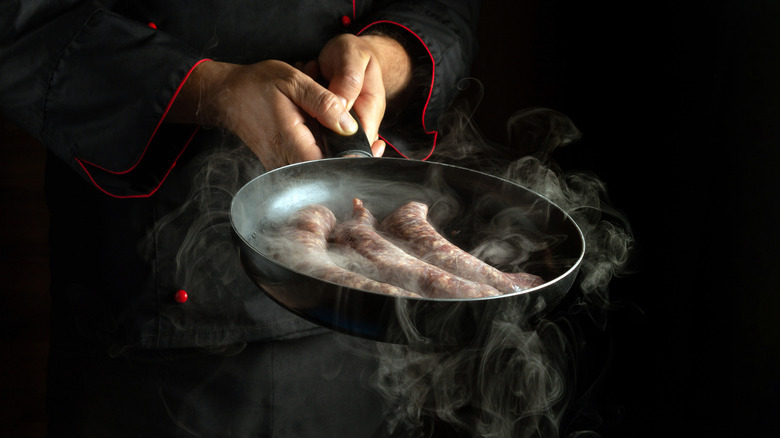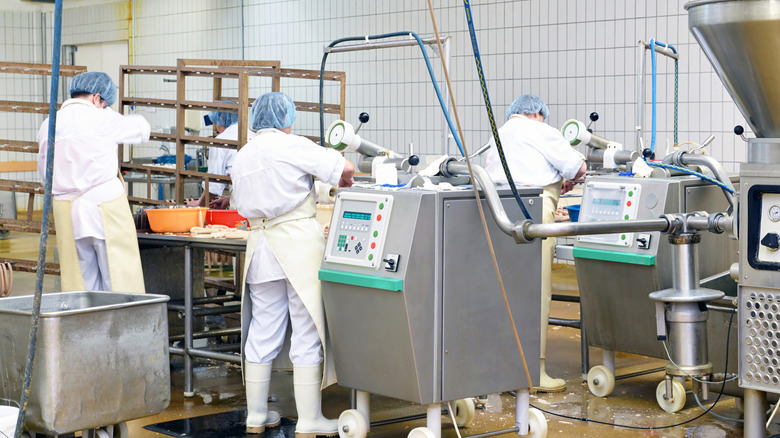Uncovering The Secret Practices Of Sausage Brands
Ah, the many joys of sausage. Many of us love it for its plump and juicy texture, as well as its unmatched umami edge, the food's versatility, and its oftentimes delightfully spicy savor. But as most of us know, not all sausages are created equal. Some sausage brands out there are putting out what you may consider to be low-quality products using a variety of tactics that may make their sausages appear more appealing and toothsome to customers, though these moves don't necessarily heighten quality once you bite into the meal.
It can be exceedingly difficult to know the difference between one brand of sausage compared to another unless you're informed of the common practices brands employ when making mass-produced sausages, as well as understanding the laundry list of ingredients that can often be found on sausage labels. But this knowledge can help give sausage lovers everywhere a bird's eye view, especially when it comes to the types of sausage they're eating and how they might compare to sausages of higher quality. Let's hone in on some of the most common secret practices of sausage brands.
Brands may use non-meat filler
This may or may not be news to you, but the use of non-meat fillers in sausage can really deceive the eye. Non-meat fillers are filling agents that make sausages appear plump and juicy. However, instead of using the meat we'd expect to add to its robust appeal, certain manufacturers, including those that produce plant-based sausages, instead use ingredients like flour, oats, bread crumbs, milk powder, starch, and more to bulk up their links.
Is this a bad thing? It depends. While it may not do any long-term damage to your health, there are disadvantages here. Sausages made with non-meat fillers will often be higher in carbs, especially varieties that use oats, wheat, rice flour, and bread crumbs. Additionally, these sorts of fillers will undoubtedly alter the taste and can cause the sausages to become downright bread-like and lend a grainy texture, all because the sausage you're munching on isn't purely meat.
We know the use of fillers isn't a big deal to some. But in case you think all sausage brands are made of 100% meat to achieve that plump and succulent appearance, you'll need to reconsider.
Additives can enhance coloring
Sausage manufacturers can add even more to products to make sausages look hard to resist, including sodium erythorbate and sodium bisulfite.
Sodium erythorbate not only allows sausages to cure faster, but also helps the meat retain its pink or red coloring and can enhance its natural hue. This is how many processed foods, including ham and bacon, get that glowing reddish tint that we so often associate with fresh pork and other meat products.
The other additive, sodium bisulfite, is a similar agent. However, instead of bringing out a certain color in the meat, it reduces browning. After all, most people don't want to cook up an oxidized sausage that already looks dull and unappealing compared to that bright pink hue we're all so used to. Since manufacturers want sausages to appear as fresh as possible, both sodium erythorbate and sodium bisulfite are often used interchangeably or in tandem to produce fresh-looking sausages that are ready to hit the shelves.
Flavor boosters like MSG enhance umami taste
Though there are some brands that rely on natural flavoring to enhance the taste of their sausages, there are many that opt to take what might be considered easier route. This can include the use of monosodium glutamate, otherwise referred to as MSG, in sausages (we're looking at you, Jimmy Dean). MSG can boost savory umami flavor without making manufacturers reach for other seasonings.
So, what's the deal with MSG? That all depends on who you ask. This occasionally controversial additive has caught some heat in times past due to short-term symptoms that reportedly include headaches, sweating, heart flutters, and more (via Mayo Clinic).
Since then, research indicates that MSG might not deliver the sort of blow to your health it was once reported to do, as per a 2019 review published in Comprehensive Reviews in Food Science and Food Safety. However, some individuals say that they are still sensitive to MSG and may not be too happy to find it in their sausage.
Brands may use otherwise wasted cuts of meat in sausage
Remember those non-meat fillers we mentioned earlier? Those aren't the only types of fillers you'll find in your sausages, as other common fillers draw on leftover bits of meat. As is the case with non-meat fillers, meat fillers are also used to make sausages look full and tasty. And while meat fillers might seem to be a better option than non-meat ones, you may want to wait until you hear the full gamut of details before you make a final decision.
Mechanically deboned meat, otherwise known as MDM, uses meat alternatives that aren't usually pork. Even if it is, it may not be exactly the kind of pork you'd want to consume in its unaltered form, including glands, pork hearts (currently listed on packages of Bar-S Classic Smoked Sausages), head parts, connective tissue, and organ meats. While you'll occasionally see these ingredients listed directly on packages, they're more commonly labeled as something like mechanically separated turkey, making it difficult to know exactly could be in those sausages you've been eating.
Longer shelf life may mean more money for manufacturers
What does long shelf life have to do with money? A lot, actually. Given that sausages can be held as-is for a lengthy amount of time gives manufacturers a chance to lower costs both for themselves and for the public. But how does this work?
In terms of beef sausage, farmers benefit from getting meat just before autumn, when cows have grown nice and plump. This doubles as a cost-saving effort, as farmers won't have to worry about supplying cattle with food during the winter.
However, because this is a seasonal process, beef sausages obtained this way will only last so long before going kaput. It's at this point that creating a sausage with a longer shelf life makes sense, as it will keep food from going to waste while providing customers with the year-long sausage they crave. This in turn allows the manufacturer to sell the sausage at a reasonable price rather than one that's jacked up due to its fresh and thereby perishable nature.
Water is added to some sausages
We'll admit that this ingredient isn't nearly as nefarious as others may seem. After all, who would balk against a little water in their sausage, especially if it can boost the product's moisture? Is adding water to sausages even worth mentioning here?
Actually, it is. While the use of water would seem to be a rather simple and even necessary component to sausage making, the truth is that adding it could cause your sausages to take a bit of a left turn during the cooking process. The problem comes when the heat from cooking comes in contact with your sausage. As your sausage heats through, the water that was used to make it look plump and juicy suddenly evaporates into thin air. The result? You could be left with a wrinkly, unattractive sausage casing and less meat than you previously thought. And while the sausage will still likely taste just fine, it probably won't be as juicy as it appeared when you first bought it.
A lot of salt can make sausages taste better
This may not necessarily be a secret to many consumers, but salt sure does taste good, doesn't it? Sausage manufacturers know this and may load up sausages with salt to help elevate the flavor of their product.
Don't get us wrong, as we understand that salt plays an important role in the curing process. Still, sausages tend to be remarkably high in sodium despite a recent concerted effort on behalf of the sausage industry to bring sodium levels down and so attract more customers. This includes efforts to use additives like potassium chloride, which can allow sausage companies to reduce the amount of sodium in their sausages. However, you can still expect the sodium content to remain high in some brands, with some comprising as much as 22% of your daily value of sodium for a measly 2-ounce serving.
After all, potassium chloride is an additive that is essentially salt that's been derived from ocean water or mined sources. This type of salt helps manufacturers cut the amount of sodium in products, but most sausages nevertheless remain high in sodium. Those with dietary restrictions that necessitate a potassium-limiting diet should still avoid sausages that contain potassium chloride, as this additive could aggravate certain conditions like kidney disease and diabetes (via Center for Science in the Public Interest).
Sugar can enhance sausage flavoring
We all know that sugar is a no-brainer when it comes to flavor enhancement, but unless you're snacking on maple-flavored sausage (or something similar), you may not consider the addition of sugar necessary when it comes to sausage making. In actuality, the sweetness of sugar and other additives can balance out salty elements in the sausage, yielding an all-around delicious final result that your tastebuds crave.
Other additions besides normal table sugar usually include corn syrup and dextrose. Corn syrup is effectively sugar that's refined from corn and provides a sweet yet subtle flavor that lends itself perfectly to umami sausages. Since it isn't overpowering in terms of sweetness, it can add a nicely balanced savor to sausages, though some consumers may be wary of its highly-processed nature.
However, rapidly-digested dextrose can cause spikes in blood sugar, as per WebMD, so it may not be the best addition for sausage-loving diabetics, so be sure to watch out for brands that often feature this ingredient in its sausages.
Brands may use soy protein to enhance texture
Noticing the use of soy protein in your sausage? There's a reason for that. Soy protein, sometimes also labeled as soy protein isolate, is often used in sausages to improve moisture retention. The disappointing shrivel factor that sometimes plagues sausage meat is usually a result of moisture loss, so the addition of soy protein could change all that by helping sausages retain water, resulting in a smooth consistency and better resistance against that dreaded shrinkage.
Is soy protein safe? Maybe. Like so many other additives, there seem to be conflicting reports regarding its safety, mainly because of all the variables that can affect how it impacts individuals (via Harvard T.H. Chan School of Public Health). However, some people with sensitivities to soy may experience some rather unsavory effects after consuming it that may include nausea, tingling, itching, wheezing, abdominal pain, and more (via WebMD). If you suspect that you are allergic to soy protein, definitely keep a lookout for brands that might feature it, as this is a common additive.
Nitrates and nitrites are often used for preservation
Ever wonder how your sausages stay as fresh as they do for so long? Nitrates and nitrites have long been used as a means of preserving cured meats. While these ingredients are very beneficial when it comes to prohibiting bacteria growth, adding color, and giving our sausages salty depth, both are known for to be potentially carcinogenic when consumed in excess (via Healthline).
Now, we'll admit that there is conflicting information out there when it comes to the effect of nitrites and nitrates on the human body, though the general consensus seems to be that they're not especially good for you, with groups like the World Health Organization and the American Institute of Cancer Research recommending you avoid regularly consuming processed meats like sausage. If you plan to eat sausages by the droves, you may be increasing your risks of complications down the road.
Oh, and in case you're wondering, the M.D. Anderson Cancer Center notes that nitrate-free curing agents might still contain these compounds and could still potentially be linked to cancer.
Citric acid mimics the flavors of fermentation
Love satiating your hunger with snack sticks or summer sausage? These semi-dried or fully dried cured sausages have a yummy, uniquely tangy flavor that's usually a result of fermentation. Yet, true to the style of typical mass production, sausage makers have found a way to circumvent the lengthy fermentation process by adding something to the mix that can imitate that tang and make it virtually impossible for anyone to tell the difference.
The additive of choice? Citric acid. Believe it or not, this simple additive can add enough tangy flavor to your cured dry sausages to get them to mimic fermented sausages, yet without the complicated and time-consuming fermentation process. Unlike the natural form of citric acid that's often found in citrus fruits, manufactured citric acid may cause adverse reactions in individuals who are sensitive to it (via Healthline). Nevertheless, this additive is generally considered to be safe to consume and can work to not only improve the flavor of foods but can also act as a preservative as well.
Higher production mean better discounts for manufacturers
Since sausage companies have essentially cracked the code for making sausages the quick and easy way, they are also well situated to capitalize on this expedited process. By using machinery, additives, and other workaround, sausage brands can churn out a higher number of sausages than they would otherwise. The result? Manufacturers are able to purchase goods in bulk at discounted prices due to the sheer volume of sausages they produce each day. This means more cash in their pockets but also a lower price for us all.
Is this something to be upset or concerned about? It could be that the higher production rate and seemingly lower cost will essentially cost us, too. With the use of scrap meat, additives, and various forms of filler, it's quite possible that we're doing a number on our health in the name of getting a quick and cheap sausage. You may also want to consider the sort of working conditions faced by company employees, who can be faced by intense working conditions that take a toll on their physical and mental health, as per reporting from the Factory Farming Awareness Coalition. Take it for what you will, but as always, we recommend you keep a close eye on the type of sausage you buy, including the ingredients, to ensure what you're purchasing is actually what you want.












